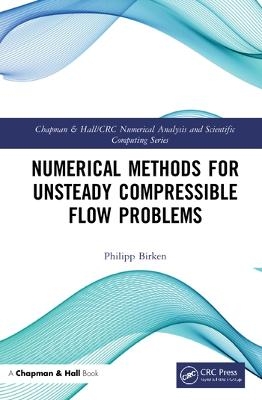
Numerical Methods for Unsteady Compressible Flow Problems
Chapman & Hall/CRC (Verlag)
978-0-367-45775-4 (ISBN)
Numerical Methods for Unsteady Compressible Flow Problems is written to give both mathematicians and engineers an overview of the state of the art in the field, as well as of new developments. The focus is on methods for the compressible Navier-Stokes equations, the solutions of which can exhibit shocks, boundary layers and turbulence. The idea of the text is to explain the important ideas to the reader, while giving enough detail and pointers to literature to facilitate implementation of methods and application of concepts.
The book covers high order methods in space, such as Discontinuous Galerkin methods, and high order methods in time, in particular implicit ones. A large part of the text is reserved to discuss iterative methods for the arising large nonlinear and linear equation systems. Ample space is given to both state-of-the-art multigrid and preconditioned Newton-Krylov schemes.
Features
Applications to aerospace, high-speed vehicles, heat transfer, and more besides
Suitable as a textbook for graduate-level courses in CFD, or as a reference for practitioners in the field
Philipp Birken is an associate professor for numerical analysis and scientific computing at the Centre for the Mathematical Sciences at Lund University, Sweden. He received his PhD in mathematics in 2005 from the University of Kassel, Germany, where he also received his habilitation in 2012. He was a PostDoc and a consulting assistant professor at the Institute for Computational & Mathematical Engineering at Stanford University, USA. His work is in numerical methods for compressible CFD and Fluid-Structure-Interaction.
Preface. 1. Introduction. 1.1. The method of lines. 1.2. Hardware. 1.3. Notation. 1.4. Outline. 2. The Governing Equation. 2.1. The Navier-Stokes Equations. 2.2. Nondimensionalization. 2.3. Source terms. 2.4. Simplifications of the Navier-Stokes equations. 2.5. The Euler Equations. 2.6. Solution theory. 2.7. Boundary layers. 2.8. Boundary layers. 2.9. Laminar and turbulent flows. 3. The Space discretization. 3.1. Structured and unstructured Grids. 3.2. Finite Volume Methods. 3.3. The Line Integrals and Numerical Flux Functions. 3.4 Convergence theory for finite volume methods. 3.5. Source Terms. 3.6. Finite volume methods of higher order. 3.7. Discontinuous Galerkin methods. 3.8. Convergence theory for DG methods. 3.9. Boundary Conditions. 3.10. Spatial Adaptation. 4. Time Integration Schemes. 4.1. Order of convergence and order of consistency. 4.2 Stability. 4.3. Stiff problems. 4.4. Backward Differentiation formulas. 4.5. Runge-Kutta methods. 4.6. Rosenbrock-type methods. 4.7. Adaptive time step size selection. 4.8. Operator Splittings. 4.9. Alternatives to the method of lines. 4.10. Parallelization in time. 5. Solving equation systems. 5.1. The nonlinear systems. 5.2. The linear systems. 5.3. Rate of convergence and error. 5.4. Termination criteria. 5.5. Fixed Point methods. 5.6. Multigrid methods. 5.7. Newton's method. 5.8. Krylov subspace methods. 5.9. Jacobian Free Newton-Krylov methods. 5.10. Comparison of GMRES and BiCGSTAB. 5.11. Comparison of variants of Newton's method. 6. Preconditioning linear systems. 6.1. Preconditioning for JFNK schemes. 6.2. Specific preconditioners. 6.3. Preconditioning in parallel. 6.4. Sequences of linear systems. 6.5. Discretization for the preconditioner. 7. The final schemes. 7.1. DIRK scheme. 7.2. Rosenbrock scheme. 7.3. Parallelization. 7.4. Efficiency of Finite Volume schemes. 7.5. Efficiency of Discontinuous Galerkin schemes. 8. Thermal Fluid Structure Interaction. 8.1. Gas Quenching. 8.2. The mathematical model. 8.3. Space discretization. 8.4. Coupled time integration. 8.5. Dirichlet-Neumann iteration. 8.6. Alternative solvers. 8.7. Numerical Results. A. Test problems. A.1. Shu-Vortex. A.2. Supersonic Flow around a cylinder. A.3. Wind Turbine. A.4. Vortex shedding behind a sphere. B. Coefficients of time integration methods. Bibliography. Index.
| Erscheinungsdatum | 06.07.2021 |
|---|---|
| Reihe/Serie | Chapman & Hall/CRC Numerical Analysis and Scientific Computing Series |
| Zusatzinfo | 54 Line drawings, black and white; 54 Illustrations, black and white |
| Sprache | englisch |
| Maße | 156 x 234 mm |
| Gewicht | 476 g |
| Themenwelt | Mathematik / Informatik ► Informatik ► Theorie / Studium |
| Mathematik / Informatik ► Mathematik ► Analysis | |
| Mathematik / Informatik ► Mathematik ► Angewandte Mathematik | |
| Technik ► Maschinenbau | |
| Technik ► Umwelttechnik / Biotechnologie | |
| ISBN-10 | 0-367-45775-X / 036745775X |
| ISBN-13 | 978-0-367-45775-4 / 9780367457754 |
| Zustand | Neuware |
| Haben Sie eine Frage zum Produkt? |
aus dem Bereich


